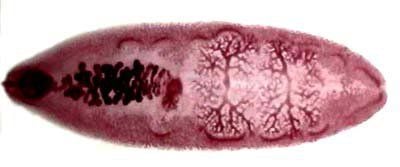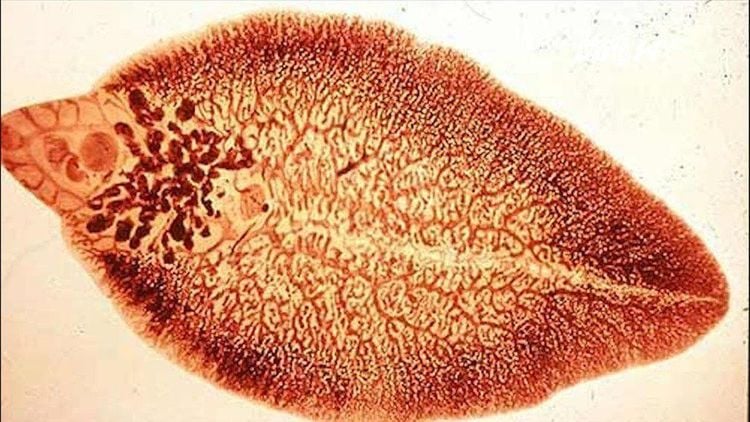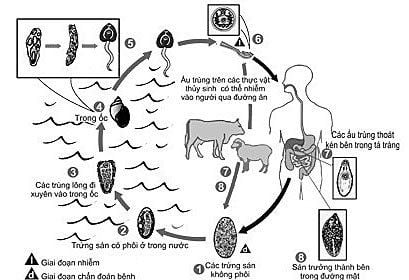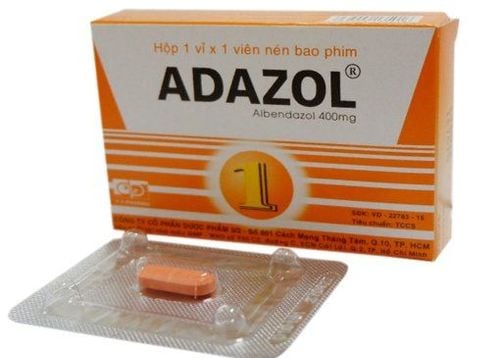This is an automatically translated article.
The article is expertly consulted by MSc.BSCKII Phan Thi Minh Huong - Gastroenterologist, Vinmec Danang International General Hospital.According to the Department of Preventive Medicine - Ministry of Health, liver fluke disease includes small liver fluke and large liver fluke, this is an infectious disease transmitted through the digestive tract, the symptoms of the disease are often similar to other diseases of the liver. liver. So what is the cause of liver fluke? What are the symptoms of the disease and how to prevent it?
1. What is the cause of liver fluke?
Liver flukes include fascioliasis and fascioliasis.Small liver fluke: there are 3 types of Clonorchis sinensis; Opisthorchis viverrini; Opisthorchis felineus Large liver fluke: there are 2 types Fasciola hepatica; Fasciola gigantica Shape: The large liver fluke and the small liver fluke are both leaf-shaped, with a flat body and thin margins. Size varies by species; The large liver fluke is larger in size than the small liver fluke. The body of the fluke is all hermaphroditic, with both testes and ovaries on a fluke body.

Sán lá gan nhỏ

Sán lá gan lớn
Trắc nghiệm: Làm thế nào để bảo vệ lá gan khỏe mạnh?
Làm test trắc nghiệm kiểm tra hiểu biết về gan có thể giúp bạn nhận thức rõ vai trò quan trọng của gan, từ đó có các biện pháp bảo vệ gan để phòng ngừa bệnh tật.2. How are people infected with liver fluke?
Small liver fluke disease: The main host is humans and some animals such as dogs, cats, tigers, foxes, otters, mice; The first intermediate host is Bythinia snails, Melania, the second vector is freshwater fish...
People infected by eating fish or snails containing undercooked fluke larvae are After eating this larva into the stomach, down the duodenum and then back up the bile duct to the liver, it develops into an adult liver fluke that parasitizes and causes disease in the biliary tract.

Vòng đời sán lá gan lớn
Large liver fluke disease: The main host is herbivores such as buffaloes and cows; Humans are just random hosts, the intermediate host is the Lymnaea snail.
People are infected by eating raw vegetables growing under water (sage leaves, spinach, celery, watercress...) or drinking water contaminated with tapeworm larvae.
3. What are the symptoms of liver fluke disease?
3.1. Incubation period
The incubation period of small liver fluke and large liver fluke both depends on the number of larvae ingested and the response of the host. For small liver flukes infected with more than 100 flukes, there is a clear manifestation, while for small flukes, there are signs of infection. With large liver flukes, the incubation period is difficult to accurately determine.3.2. Transmission period
For small liver flukes:
After entering the liver parenchyma, the young fluke will develop into an adult fluke and lay eggs in the bile ducts, the eggs are excreted in the feces and into the water to develop in the urine. closed cycle and then transmitted by eating raw fish with cysts.
Due to parasites in the biliary tract, when infected with small liver flukes may have the following manifestations:
Often there are symptoms of pain in the liver due to the fluke reproduction causing blockage of the bile ducts in the liver leading to right upper quadrant pain . Digestive disorders (poor appetite, stomach bloating, indigestion); Sometimes there is darkening of the skin, jaundice and signs of hepatomegaly or cirrhosis depending on the severity of the disease. In severe cases, small liver flukes can cause cholangitis, biliary bleeding, cholangiocarcinoma, biliary cirrhosis... For large liver flukes:
After infiltrating the liver parenchyma from 2 -3 months, the fluke will enter the bile duct, mature and lay eggs, the eggs are excreted in the feces and enter the water to hatch into hairy larvae and then through snails and develop into tail larvae and cysts that cling to vegetables. Aquatic or swimming in water, if people or herbivores eat the cysts, they will enter the stomach, intestines, then the liver and parasitize in the liver. In the liver, adult flukes can parasitize and cause disease for many years.
Patients infected with fascioliasis often have the following manifestations:
Pain in the right lower quadrant spreading to the back or pain in the epigastrium and nasopharynx; Pain is non-specific, can be dull, sometimes severe, sometimes without abdominal pain. Patients are tired, have a feeling of fullness, indigestion, digestive disorders, nausea, possible fever or joint pain, muscle pain and rash... Some cases of large liver fluke cause liver abscess, disease Severe right lower quadrant pain, fever, enlarged liver. If the abscess bursts into the lung, it can cause pleural effusion, a serious condition. Some cases of ectopic parasites such as in the lungs, under the skin of the chest.... Symptoms of liver fluke disease are similar to other liver diseases such as viral hepatitis, cholangitis caused by stones, cancer. liver cancer , or liver abscess due to other causes ... so the patient should be carefully examined for appropriate treatment .
4. How do I know if I have a liver fluke infection?
If suspected tapeworm infection, the patient can go to the hospital for testing:
Small liver fluke: the test finds eggs in stool or duodenal fluid. fascioliasis: the test finds eggs in the stool or the blood test by immunoassay (ELISA) finds antibodies to the liver fluke in the patient's serum. In addition, in the case of ectopic helminths, imaging tools are required to locate the parasites such as CT, MRI...
5. How to treat liver fluke?
When being diagnosed with liver fluke infection, the patient needs to be treated early, with adequate doses and specific drugs prescribed by the doctor, in addition, the patient needs to be fostered to support his condition.However, there are some cases with contraindications to treatment: pregnant women, people with acute diseases, liver failure, severe kidney failure, allergies to drugs needed...
>>> Cure the disease Liver fluke after only 3 days of treatment at Vinmec Central Park International General Hospital
6. Prevention of liver fluke disease
From the knowledge about the mode of transmission and harms of liver fluke, people need to take the following measures to prevent the disease:Eat cooked food and drink boiling water: especially do not eat fish and snails before they are sick. be thoroughly cooked in any form, do not eat raw vegetables that grow under water. Wash hands before eating and preparing food; after going to the toilet, contact with feces, garbage ... Manage human and animal feces, do not use fresh manure to fertilize vegetables. Use clean water for drinking. Deworming every 6 months. Liver fluke is an infectious disease transmitted through the digestive tract, the disease can cause serious complications, greatly affecting human health. If an infection is suspected, the patient must go to a medical facility for timely examination, testing, diagnosis and treatment.
Please dial HOTLINE for more information or register for an appointment HERE. Download MyVinmec app to make appointments faster and to manage your bookings easily.
Reference source: Department of Preventive Medicine - Ministry of Health












